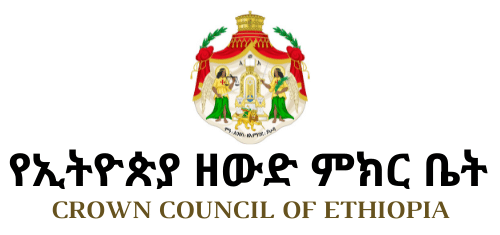
THE IMPERIAL ARMS OF ETHIOPIA
© Hubert deVries 2009-11-04; Updated 2015-07-11.


Representing the achievement
On an uncertain date but somewhat before 1909, an Imperial Achievement was designed which replaced the older coat of arms.7
The achievement is as follows:
- Emblem: The Lion’s Throne of Solomon, on its seat an orb proper, on its back a Solomon’s seal.
- Exterior Ornaments: The archangels Michael and Gabriel vested Or and Vert, on their breasts a square cross patonce, above the throne an open Bible between the Amharic letters Alef, Wau, and Alef; before the throne the Ethiopian Lion, walking to the dexter.
- Motto: The Conquering Lion of the Tribe of Judah, on his procession cross a note.
- Mantle: On two branches of olive, Gules, lined Argent, fringed and tasseled Or, crowned with the Imperial Crown of Ethiopia.

This achievement demonstrates the claim of the Ethiopian rulers that they descended from Solomon, king of the united monarchy of Israel (970-931 BC) and which served to legitimize their power. Its central symbol is the Throne of Solomon, mentioned in the Bible:
1 Kings 10 : 18 Moreover the king made a great throne of ivory, and overlaid it with the best gold. 19 The throne had six steps, and the top of the throne was round behind: and there were stays on either side on the place of the seat, and two lions stood beside the stays. 20 And twelve lions stood there on the one side and on the other upon the six steps: there was not the like made in any kingdom.
2 Chronicles 9 : 17 Moreover the king made a great throne of ivory, and overlaid it with pure gold. 18 And there were six steps to the throne, with a footstool of gold, which were fastened to the throne, and stays on each side of the sitting place, and two lions standing by the stays: 19 And twelve lions stood there on the one side and on the other upon the six steps. There was not the like made in any kingdom.

Coll. Musée Quai Branly, Paris [10]
Imperial achievement of HIM Haile Selassie I
*1892-†1975
Regent 1916-1930; King 1928; Emperor 1930-1974
It is the same as the achievement of his predecessor Menelik II, but the lion walking to the sinister, keeping the processional cross in his dexter paw, the note replaced by a streamer in the national colours.
The Lion’s Throne was from ancient Egyptian times the seat of the ruler. In the European Middle Ages, it was the seat of kings but only in a very few cases these thrones can be interpreted as the Throne of King Solomon. Such an exception is the throne on which the Roman Emperor Henry VI (1190-97) is sitting in the manuscript of Petrus of Ebulo.8
On the back of the throne is a hexagram which can be interpreted as the symbol of King David, the father of Solomon and in this case the symbol of the Ethiopian Solomonic Dynasty.

© The Dean and Canons of Windsor
The orb is the common symbol of the Empire, the orb with the cross the symbol of a Christian Empire.
The archangels Gabriel and Michael are also mentioned in the Bible.9 They are the main spokesman and the main warrior of the Jewish and Christian God and in this sense, they were also adopted by Islam. The two archangels are always depicted winged and armed, Gabriel holding a balance as a symbol of the Last Judgement, and Michael a palm leaf as a symbol of Victory. In the time of the designing of the Ethiopian achievement the two archangels were the supporters of the arms of the Emperors of Russia.
The crown is the symbol of administrative power, the Imperial crown of Ethiopia the symbol of the supreme administrative power with which the Emperor is invested. On the front of the crown is the effigy of St. George slaying the dragon. St. George can generally be interpreted as the personification of the Defender of the Faith and in this way the qualification of “Servant of the Cross” of the mediaeval rulers of Ardeslib became a part of the Ethiopian imperial presentation.
Notes as shown on website specific to this section:
7) The oldest representations available on stamps issued 1911.
8) Ebulo, Petrus de: Liber ad Honorem Augusti sive de rebus Siculis. Codex 120 II der Burgerbibliothek Bern, fol. 147.
9) Gabriel in Daniël 8 : 16 and Lucas 1 : 19 and Michael in Daniël 10 : 13 and Revelation 12 : 7.
10) N° inventaire : 71.1940.3.4 D / Toponyme(s) : Afrique /Afrique orientale / Ethiopie / Précédente collection :Musée de l’Homme (Afrique) / Matériaux et Techniques :Bois, pigments /Dimensions : 72,5 x 62 x 3,5 cm, 1280 g / Objet non exposé


